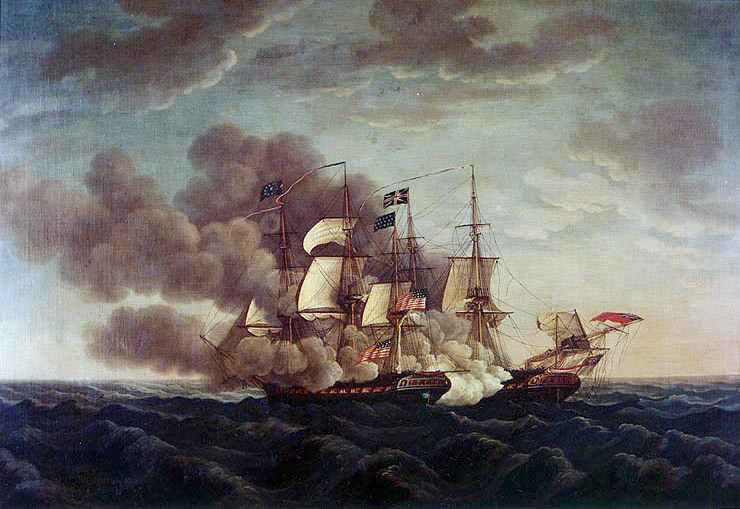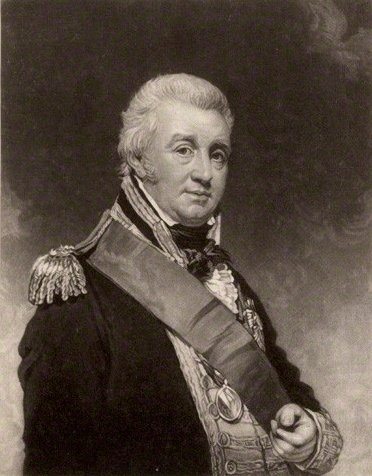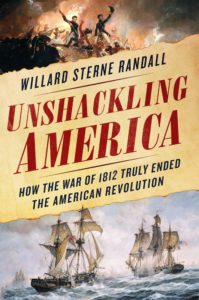By Willard Sterne Randall
The War of 1812, often called “the forgotten conflict,” is probably the least understood American war. Just as frequently, it is described as the Second War of American Independence. This is because of a persistent fallacy that Americans fought two separate wars of independence. In fact, Americans endured one unremitting fifty-year-long struggle for economic independence from Britain that overlapped two armed conflicts linked by an unacknowledged global struggle. Throughout this perilous period, the struggle was largely about free trade, what Winston Churchill described in his monumental History of the English Speaking Peoples as an “unofficial trade war.”

Neither Washington or Jefferson nor any other Founding Father could divine that the Revolutionary Period of 1763 to 1783 had concluded only one part, the first phase of their ordeal. The Treaty of Paris of 1783, which ended the Revolutionary War, halted overt combat but it achieved only partial autonomy from Britain. By not guaranteeing American economic independence and agency, Britain continued to deny American sovereignty. It would take a second armed conflict between 1812 and 1815 before the U. S. finally secured its complete independence. The recent observance of the bicentennial of the War of 1812 did little to reevaluate the final act of a dramatic fifty-year-long American Revolution.
For fully three decades after the Revolutionary War ended, the second phase of the American Revolution combined a domestic ideological crisis over American identity with unrelenting and ever-intensifying attempts by the British to stifle American trade and to starve her former colonies. From 1783 until combat resumed in 1812, the United States’ weak central government and a military enfeebled by Jeffersonian political purges rendered the young nation’s chance of survival dubious.
Ignoring the Treaty of Paris, the British Parliament ratcheted up efforts to eliminate American competition. Re-invoking the colonial-era Navigation Act of 1756, Parliament required that all goods transported to, from and between England and its possessions must be carried on British ships. By banning long-existing trade between New England and its Canadian neighbor, the Act also barred flourishing commerce with British Caribbean colonies. Moreover, Britain insisted that its treaty allies, Spain and Portugal, embargo American trade and forbid U.S. trade with any of their colonies. Britain also prohibited vital exports from England to the U. S., such as sheep, wool and woolens. All the while, in violation of the peace treaty, Britain refused to remove its troops from fortified trading posts around the Great Lakes and along the Canadian-American frontier.
As the Napoleonic Wars spread over Europe in the 1790s, Britain denied the United States’ neutral maritime rights. Despite increasing British restrictions, the U. S. developed the world’s second largest merchant fleet as it absorbed the French Caribbean trade. America’s carrying trade increased fivefold between 1790 and 1800, its tonnage nearly doubling again between 1800 and 1812.
With a 900-ship Royal Navy notorious for harsh discipline and frequent desertion, England turned to impressment of American sailors to fill out its crews. “Bad feeling between the governments,” writes British economic historian Brian Arthur, “was further exacerbated by the impressment by the Royal Navy of apparently British seamen from American merchant ships at sea.” Many of the impressed sailors had been born in Britain and become naturalized American citizens; nearly as many were deserters who could purchase false papers for as little as $1. Britain refused to acknowledge the novel U. S. doctrine of naturalization. The allegiance of British seamen found aboard neutral ships was, according to the Prince Regent, ‘no optional duty which they can decline or resume at pleasure,’ but ‘began with their birth and can only terminate with their existence.’
Between 1790 and 1812, some 9,900 crewmen were taken off American merchant ships. Historian Gordon Wood contends that “it was not the actual number of seizures that most irritated Americans; rather it was the British presumption that His Majesty’s government had the right to decide just what American trade should be permitted or not permitted. It seemed to reduce America once again to the status of a colonial dependent.”
Yet the pressure for a declaration of a second war against Britain came not from coastal merchants and ship owners but from the frontier states of Ohio, Kentucky and Tennessee. Shawnee chieftain Tecumseh had organized a tribal confederacy capable of fielding 10,000 warriors, twice the strength of the peacetime American military. Panic gripped settlers after a pitched battle between American militia and restive Indians at Tippecanoe in Indiana Territory in 1811. A new alliance of Warhawk Democrats in Congress led by firebrand Henry Clay of Kentucky persuaded President James Madison to declare war on England in June, 1812. At stake was the rich fur trade with the Indians. Tecumseh, in exchange for arms and expecting a vast hunting reserve that would block further American expansion to the West, pledged his warriors to buttress weak British garrisons in Canada.
Part of the mythology is that he War of 1812 was an accident of primitive communications: if a message from London that the King’s Privy Council had decided to relax restrictions on American trade had reached the U.S. before the ship carrying America’s declaration of war across the Atlantic landed in London before hostilities actually commenced, the War of 1812 could have been averted.
On receiving the American declaration, the British Ministry offered an armistice, ostensibly to allow time for diplomatic negotiations. Madison rebuffed it. He suspected the British were stalling while they built up their forces in poorly defended Canada. He noted that the British had not abandoned their policy of impressment.
Americans favoring the war expected a swift and easy victory and possession of all Canada, thus depriving the Indians of support and winning a monopoly on North America’s lucrative fur trade. Former President Jefferson predicted that taking Canada would be “a mere matter of marching.” In London, the British public was furious to be “stabbed in the back” by the Americans just as Napoleon marched his armies into Russia, Britain’s ally.
It is also mythical that he British burning of Washington, D. C. in August, 1814, was unprovoked and unprecedented. In the first of three failed American invasions of Canada, a fleet carrying American riflemen commanded by a newly-minted General Zebulon Pike, famous for his western explorations, attacked York (present-day Toronto). Retreating, the British commander ordered demolition of 500 barrels of gunpowder. Pike and hundreds of Americans were killed or maimed. Americans, mistaking the wig of a parliamentarian for a scalp, in a three-day rampage torched the government buildings and sacked private homes and a church.
After Napoleon capitulated in April, 1814, Britain sent massive reinforcements to America. In overall command was Vice Admiral Alexander Forester Inglis Cochrane, son of an earl whose older brother had been killed by a cannonball at Yorktown. Alexander Cochrane received a letter from British governor general Sir George Prevost in Canada, averring that American forces raiding supply bases around Lake Erie had looted homes and burned private property in five towns. Prevost asked Alexander Cochrane to “assist in inflicting that measure of retaliation which shall deter the enemy from a repetition of similar outrages.” Alexander Cochrane promptly issued orders to captains and commanders to retaliate, “to destroy & lay waste such Towns and Districts upon the Coast as you may find assailable.”

Alexander Cochrane left the decision whether to attack the undefended Washington to two subordinates, Rear Admiral George Cockburn, scourge of planters around the Chesapeake, and General Robert Ross, a veteran of the war in Europe. He supplied them with incendiary devices – papier mache balls filled with a flammable liquid — to sling through shattered windows of targeted government buildings. After routing the ill-prepared American militia at Bladensburg, Maryland — who fled so fast the episode became immortalized as the Bladensburg Races– the British torched the White House, the Capitol and all other government buildings. They spared only the post office, which housed the patent office, on the grounds that models submitted for patent were private property.
One month later, after the British failed to seize Baltimore and its hundreds of privateering ships despite an all-night naval bombardment of Fort McHenry, Alexander Cochrane and his armada sailed south to their principal objective, New Orleans, key to the Mississippi and the Louisiana Purchase. Dispatches to American peace negotiators John Quincy Adams and Henry Clay at Ghent, Belgium, alerted them to the American victory at Baltimore and the defeat of a British invasion fleet on Lake Champlain that forced an unsupported British army to turn back to Canada.
At this news, the Duke of Wellington, who had vanquished Napoleon’s armies in Spain and France, declined the American command. He urged the British Cabinet to negotiate peace. On Christmas Eve, 1814, the Treaty of Ghent, which returned all borders to their status quo ante bellum, formally ended the war.
But the British Cabinet did not trust Madison. Under the treaty, hostilities would continue until both sides had signed. Two weeks later, while the treaty was on a ship sailing to New York, the British attacked New Orleans, only to be slaughtered by Andrew Jackson’s sharpshooting frontiersman, Creole militiamen and American artillery.
Neither Jackson nor the British commanders could know that the treaty would not arrive in Washington for five more weeks. In a midnight session of the Senate, the War of 1812 as well as the American Revolution, ended by candlelight in the old Post Office building, the only surviving government building.
The last minute string of American victories and British defeats in the waning months of the war convinced Americans that they had won. British invasions from the north, east and south had failed as certainly as three American invasions of Canada had succeeded only in uniting French and English Canadians to fight side by side for their newly-appreciated homeland.
No one had won, least of all American Indians, abandoned by the British on the battlefield and at the peace talks. The U. S. Treasury was empty, the government bankrupt; the supplier of copper to the mint had refused further credit, so there was no 1815 penny. But the British Cabinet could no longer persuade Parliament to exact triple property taxes to fight on.
America had emerged with a new hero, Andrew Jackson, who would parlay the killing of thousands of Indians and British to the White House. Thousands of American merchant mariners, commissioned as privateers, had stalemated the mighty Royal Navy, capturing more than 1,500 British ships. They now turned to sailing the world’s ocean’s unshackled from British restrictions.
The real winner was free trade.
WILLARD STERNE RANDALL is the author of Unshackling America: How the War of 1812 Truly Ended the American Revolution, a journalist and author of several biographies of Founding Fathers. He is a Distinguished Scholar in History and Professor at Champlain College. He lives in Burlington, Vermont with his wife Nancy Nahra, with whom he has co-authored several volumes of history.

